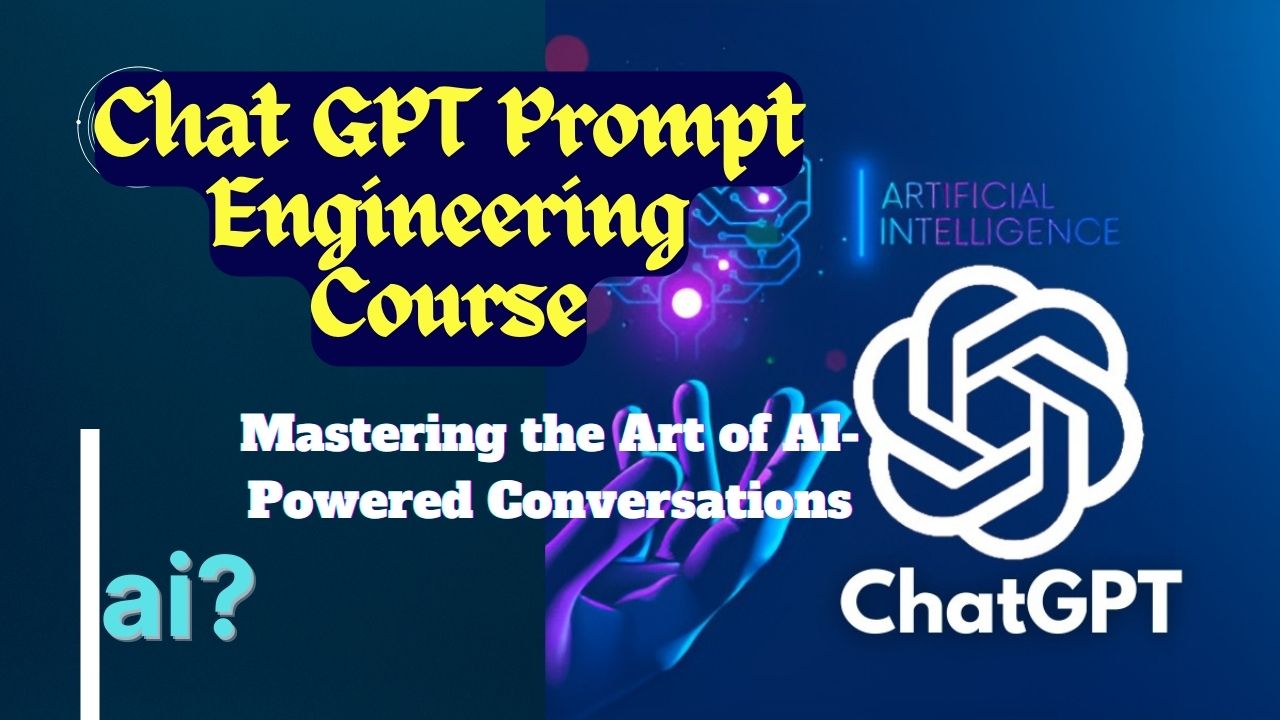Introduction
Chat GPT Prompt Engineering Course has evolved as a critical talent in the fast evolving realm of artificial intelligence. Mastering the art of timely engineering is critical as organizations increasingly rely on chatbots and virtual assistants to communicate with their customers. In this article, we'll go deep into the realm of Chat GPT Prompt Engineering Course, delving into its complexities, best practices, and the path to become a skilled prompt engineer.
Understanding Chat GPT Prompt Engineering Course
Certainly! "Chat GPT Prompt Engineering Course is the cornerstone of creating effective chatbot interactions," according to the release. It entails programming prompts or messages to elicit desired responses from AI models such as GPT-3. In basic terms, these cues serve as instructions to the AI, directing it to generate human-like writing in response."
"Chat GPT Prompt Engineering Course is a fundamental skill for creating effective chatbots." It's all about crafting particular signals that cause AI models like GPT-3 to respond in the way you desire. Consider these messages to be instructions for the AI, assisting it in producing language that sounds just like something a person would say in response."
The Fundamentals of Prompt Engineering
Certainly! "To excel in Chat GPT Prompt Engineering Course, you must understand the fundamental principles." It all starts with understanding the capabilities and limitations of the AI model you're using. It is critical to be familiar with GPT-3's behavior and language peculiarities." This can be expressed as follows:
"It is critical to have a strong foundation in basic concepts in order to become proficient in Chat GPT Prompt Engineering Course." This begins with determining exactly what your AI model can and cannot perform. It is critical to understand how GPT-3 behaves and its various language nuances."
Crafting Effective Prompts
Certainly! "Creating prompts that elicit accurate and contextually relevant responses is an art." It entails creating questions that are clear, succinct, and unambiguous. Experimentation and iteration are important components of this process," which can be summarized as follows:
"Creating messages that cause the AI to provide accurate and contextually appropriate responses is a skill that requires dexterity." It entails asking questions or giving instructions that are precise, brief, and leave no space for ambiguity. The technique also focuses on experimenting with different approaches and iteratively improving."
Leveraging LSI Keywords
"In chat GPT prompt engineering, Latent Semantic Indexing (LSI) keywords play a critical role in increasing the impact of your prompts." These keywords go beyond simple word matching and probe into the conversation's underlying context. By integrating LSI keywords in your prompts, you significantly increase their effectiveness.
These keywords act as subtle clues, allowing the AI model to better understand the context of the user's question. Consider these context-building bricks that help the AI understand the complexities and intricacies of the dialogue.
When LSI keywords are smoothly integrated into your prompts, it indicates a level of complexity in your prompt engineering approach. It's like adding a flourish to your directions. This innovative technique enables the AI model to not only generate responses, but also to do so with greater coherence and relevancy, making the overall chatbot interaction feel more natural and engaging."
The Role of Context in Prompt Engineering
Contextual Awareness
"Keeping context throughout a conversation is critical in the world of chatbots." A chatbot must remember what has been discussed earlier in addition to providing separate responses to user queries. The capacity to understand and maintain context is what distinguishes a good chatbot from a bad one.
In this context, effective prompt engineering entails developing prompts that are not merely one-time instructions but are linked to the continuing discourse. Consider it as dropping breadcrumbs of information to the AI as the dialogue progresses. These contextual cues act as reminders, ensuring that the AI stays on track and responds to the user's requests.
What is the significance of this? It results in smoother and more cohesive interactions. Users are not required to explain their intentions or backtrack during the conversation. Instead, customers can have a natural and meaningful conversation with the chatbot, just like they would with a human.
Assume you ask a question halfway through a conversation and the chatbot responds as if it has no memory of what was said previously. It's inconvenient and degrades the user experience. By giving contextual cues, effective prompt engineering avoids these glitches and makes the encounter more user-friendly and entertaining."
Dynamic Conversations
When you master Chat GPT Prompt Engineering Course, you get the ability to smoothly build on earlier messages. Consider it a conversation with a friend in which you refer back to previous points or continue a topic of debate. This means that the discussion becomes more fluid and context-aware in the context of chatbot encounters.
Consider the following scenario: a user asks a chatbot about a product and then inquires about its price later in the conversation. You may ensure that the chatbot remembers the previous mention of the product and offers a consistent response on its price with effective quick engineering. This level of context awareness provides users with a more human-like and enjoyable experience.
Chatbots may adapt to the user's tastes and requirements in real-time thanks to dynamic dialogues assisted by prompt engineering knowledge. Making encounters feel less artificial and more like actual talks is the goal. By mastering this ability, you will be able to design chatbots that not only deliver information, but also engage users in meaningful and contextually aware dialogues, so improving the overall user experience."
Advanced Techniques for Prompt Engineering
Conditional Prompts
Let's take a closer look at conditional prompts and their function in building dynamic chatbot experiences:
"Conditional prompts are an extremely effective technique in the armory of chat GPT prompt engineering. They enable you to shape and guide discussions based on user input or past AI answers. This feature adds a level of sophistication to chatbot conversations, making them more dynamic and user-centered.
This is how it works: Consider a chatbot that provides product information. Instead of using a fixed script, conditional prompts can be used to adapt responses based on what the user asks or mentions. For example, if a user exhibits interest in a certain product feature, the chatbot can dive more into that subject. If, on the other hand, the user inquires about pricing, the chatbot can shift gears and deliver pertinent pricing information.
Because of the complexities of conditional logic, you can put up these 'if-then' scenarios within your prompts. It's the same as giving the chatbot decision-making ability. You determine the criteria that trigger certain responses, resulting in a highly tailored and context-aware chatbot experience.
You may take chatbot interactions to the next level by delving into these complexities and understanding conditional prompts. Your chatbot evolves from a static repository of information to a dynamic conversational partner that adapts to the requirements and preferences of each user. This not only improves user satisfaction but also offers up new opportunities for organizations wishing to provide excellent customer service and engagement via chatbots."
Handling Complex Queries
Certainly, let us go more into the problem of dealing with complicated user queries as a prompt engineer, as well as the ways for dealing with them effectively:
"One of the exciting but challenging aspects of prompt engineering is dealing with complex user queries." These are enquiries that require a more nuanced and considered response than simple, clear inquiry. As a quick engineer, learning the technique of dealing with these difficult questions is critical.
To address complicated user requests effectively, you must apply specific strategies that allow you to break down the complexity and offer accurate responses:
1. **Decomposition**:
Complex questions are frequently subdivided into simpler sub-topics. Identifying these sub-questions allows you to address them one at a time, eventually building up to a thorough solution.
2. **Clarification**:
To fully comprehend the user's intent, it is sometimes important to seek clarification from them. Prompt engineers can utilize follow-up prompts to request extra information or context, ensuring that the AI's response is appropriate for the user.
3. **Using LSI Keywords**:
As previously stated, leveraging Latent Semantic Indexing (LSI) keywords can be extremely beneficial when dealing with complex queries. These keywords assist the AI model in better grasping the context of the inquiry, allowing for more accurate and coherent responses.
4. **Conditional Responses**:
Another sophisticated approach, conditional prompts, can be used to dynamically alter responses based on the specific parts of a complex inquiry. This ensures that the AI's response is customized to the user's inquiry.
5. **Iterative Testing**:
Complex queries frequently necessitate extensive testing and iteration. To fine-tune the accuracy and clarity of answers, prompt developers may need to experiment with different prompt formulations and analyze the AI's responses.
By utilizing these strategies, quick engineers will be able to confidently handle complex customer inquiries while providing relevant and accurate results. This not only improves the customer experience, but also demonstrates prompt engineers' competence in delivering high-quality interactions with chatbots."
Emulating Human Conversations
Let's go over the purpose of designing chatbots that engage users in human-like discussions, as well as the approaches for infusing personality and genuine language into your prompts:
"In the realm of chatbot development, the ultimate goal is to create AI-driven virtual assistants that can engage users in conversations that feel as natural and relatable as if they were interacting with a human." A sophisticated approach to prompt engineering is required to achieve this goal, one that goes beyond plain functionality to include the art of developing a personality and utilising natural language.
Here's how to effectively incorporate personality and genuine language into your prompts:
1. **Embrace the Art of identity**:
Consider your chatbot to be a character with a distinct identity. Consider the tone, style, and voice that are appropriate for your brand or the context in which the chatbot will be used. This character should be appealing to users and reflect the desired interaction style, which could be pleasant, professional, or casual.
2. **Use Natural Language**:
When creating prompts, attempt to sound less robotic and more human. Avoid using excessively technical or robotic jargon. Instead, use conversational and friendly language that users can easily relate to and comprehend.
3. **Incorporate Idioms and phrases**:
Including idioms, phrases, and colloquialisms in your chatbot's responses can lend a touch of authenticity. However, use them sparingly, making sure they are contextually relevant and will not confuse consumers.
4. **Inject Humor (When Appropriate)**:
Humor can be a strong tool for sparking lively discussions. If your chatbot's persona and environment allow it, a dash of levity can make interactions more pleasurable for consumers.
5. **Empathetic Responses**:
Incorporating empathy into your chatbot's responses will help consumers feel heard and understood. Recognizing user emotions and responding compassionately can improve the overall user experience.
6. **Dynamic Language**:
Rather than using static language, utilize dynamic language. Use statements like 'I can help you with that' or 'Let's get started,' for example, to make the dialogue feel more involved.
7. **Personalize Responses**:
Personalize responses based on user data or previous interactions whenever possible. Addressing users by name or remembering their preferences humanizes the conversation.
8. **Continuous Learning**:
Analyze user interactions on a regular basis to understand what works and what doesn't. To improve the chatbot's capacity to engage users effectively, adjust your prompts and responses based on this feedback loop.
You can make major advances toward designing chatbots that not only deliver information but also establish meaningful connections with consumers by mastering the art of integrating personality and natural language into your prompts. This improves the user experience, encourages interaction, and establishes your chatbot as a useful and relatable virtual assistant."
Best Practices and Pitfalls to Avoid
Common Mistakes
Certainly, let's look at how to avoid frequent errors in prompt engineering and how to prevent them:
"There are common pitfalls in the world of prompt engineering that even experienced engineers can fall into." These errors can reduce your chatbot's effectiveness and result in less-than-ideal user experiences. To design genuinely exceptional chatbots, it is critical to recognize these problems and, more importantly, to understand how to avoid them.
Here are some frequent mistakes that prompt engineers should avoid:
1. **Prompt Ambiguity**:
Vague or ambiguous prompts can confuse the AI and result in incorrect responses. It is critical to create prompts that leave no space for misunderstanding.
2. **Too Sophisticated Prompts**:
While it is vital to handle sophisticated user requests, too complex prompts can overload the AI. Even when dealing with complex issues, strive for clarity and simplicity.
3. **Ignoring User Context**:
Ignoring the context of an ongoing conversation can result in disconnected interactions. To ensure coherence, your prompts should be aware of preceding messages.
4. **Repetitive Responses**:
Repeatedly providing the same response, especially in a single chat, can irritate users. Avoid this by mixing up your prompts.
5. **Ignoring User input**:
User input is a great source of information. Ignoring it can lead to missed possibilities for growth. Engineers who are proactive should aggressively seek and act on user feedback.
6. **Lack of Personalization**:
Generic prompts that do not take into account user preferences or history can come across as robotic. Whenever possible, personalize prompts to improve the user experience.
7. **Failure to Test and Iterate**:
Prompt engineering is a process that requires iteration. Failure to test and refine multiple prompt versions based on performance can limit the chatbot's efficacy.
To avoid these common blunders, it's critical to be proactive in identifying and correcting them. Evaluate the chatbot's performance on a regular basis, collect user feedback, and fine-tune your prompt engineering strategy accordingly. By avoiding these problems, you can ensure that your chatbot offers users seamless, engaging, and effective conversations, hence improving the entire user experience."
A/B Testing
Let's take a look at the concept of A/B testing in prompt engineering and why it's important for optimizing chatbot performance:
"A/B testing is a fundamental practice in prompt engineering, and it is critical in the continuous optimization of chatbot interactions." It's a scientific strategy to enhancing chatbot performance that involves analyzing many prompt modifications to see which one works best. Here's why A/B testing is important, as well as how to plan and run effective tests:
**Why A/B Testing is Crucial**:
1. **Data-Driven Insights**:
A/B testing delivers actual, data-driven insights regarding the most successful prompts. It enables you to base your judgments on actual user interactions rather than assumptions.
2. **Continuous Improvement**:
Chatbots are dynamic, evolving over time. A/B testing ensures that your chatbot's prompts adapt in response to user wants and preferences.
3. **Optimization**:
By determining which prompt versions produce the greatest results, you may improve the performance of your chatbot, making it more efficient and user-friendly.
**Designing and Conducting Effective A/B Tests**:
1. **Define precise Objectives**:
Define precise objectives for your A/B experiments. What do you want to improve? Is the metric user engagement, accuracy, or something else?
2. **Generate versions**:
Create several prompt versions to test. These changes should be distinct in some sense, such as phrase, tone, or structure.
3. **Random Assignment**:
Make sure that users are randomized to one of the question variations at random. This eliminates bias and assures that the comparison is fair.
4. **Collect Data**:
During the A/B test, keep track of relevant metrics such as user reactions, engagement rates, and conversion rates.
5. **Statistical Significance**:
Examine the data to see if one prompt variant significantly outperforms the others. Statistical significance assists you in reaching trustworthy judgments.
6. **Iterate and Repeat**:
Using the results, adopt the most effective prompt version and iterate. Conduct A/B tests on a regular basis to modify and improve prompt performance.
7. **User Feedback**:
Supplement quantitative data with qualitative user feedback. Understanding why one stimulus works better than another can bring useful information.
8. **Segmentation**:
Think about segmenting your user base to do more targeted A/B tests. Certain prompts may elicit varied responses from various user groups.
A/B testing is a continuous process of refining, not a one-time event. By constantly reviewing and refining your chatbot's prompts using A/B testing, you ensure that it remains sensitive to user needs and provides an excellent conversational experience."
Chat GPT Prompt Engineering Course: Frequently Asked Questions (FAQs)
Q: What is Chat GPT Prompt Engineering Course?
A: Chat GPT Prompt Engineering Course is the technique of writing prompts to teach AI models such as GPT-3 how to generate human-like text responses for chatbots.
Q: Why is prompt engineering important?
A: Prompt engineering is essential for developing chatbots that can engage users, answer inquiries, and provide valuable assistance.
Q: How can I improve my prompt engineering skills?
A: To improve your prompt engineering skills, research AI model behavior, experiment with new prompts, and remain current on AI breakthroughs.
Q: What are LSI keywords, and how do they improve prompts?
A: Latent Semantic Indexing (LSI) keywords are terms that are relevant to the main topic. Incorporating them into prompts increases AI models' context understanding.
Q: Can I use Chat GPT Prompt Engineering Course for customer support?
A: Without a doubt! Chat GPT Prompt Engineering Course can be an extremely useful tool for automating customer assistance enquiries and providing timely responses.
Q: What are some advanced techniques in prompt engineering?
A: Advanced strategies for creating more interesting chatbot encounters include conditional prompts, addressing complex requests, and imitating human dialogues.
Conclusion
Mastering Chat GPT Prompt Engineering Course is a trip that will teach you how to build chatbots that not only comprehend but also engage users in meaningful discussions. You may become a good prompt engineer by following best practices, avoiding frequent mistakes, and constantly polishing your abilities. Accept the future of AI-powered chats and explore new avenues for chatbots.
Written by: Md Muktar Hossain






















